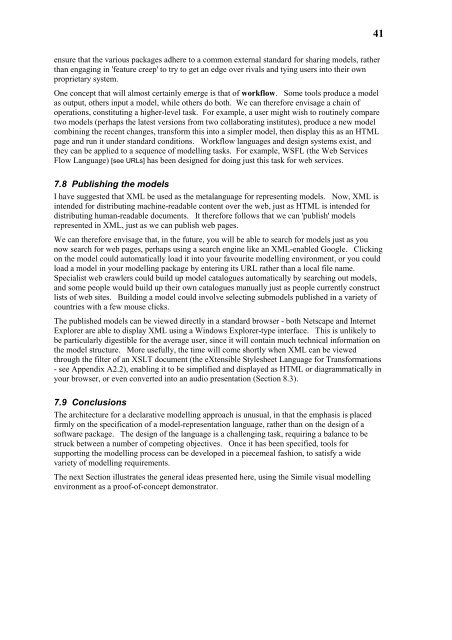pdf: 600KB - Potsdam Institute for Climate Impact Research
pdf: 600KB - Potsdam Institute for Climate Impact Research
pdf: 600KB - Potsdam Institute for Climate Impact Research
You also want an ePaper? Increase the reach of your titles
YUMPU automatically turns print PDFs into web optimized ePapers that Google loves.
41<br />
ensure that the various packages adhere to a common external standard <strong>for</strong> sharing models, rather<br />
than engaging in 'feature creep' to try to get an edge over rivals and tying users into their own<br />
proprietary system.<br />
One concept that will almost certainly emerge is that of workflow. Some tools produce a model<br />
as output, others input a model, while others do both. We can there<strong>for</strong>e envisage a chain of<br />
operations, constituting a higher-level task. For example, a user might wish to routinely compare<br />
two models (perhaps the latest versions from two collaborating institutes), produce a new model<br />
combining the recent changes, trans<strong>for</strong>m this into a simpler model, then display this as an HTML<br />
page and run it under standard conditions. Workflow languages and design systems exist, and<br />
they can be applied to a sequence of modelling tasks. For example, WSFL (the Web Services<br />
Flow Language) [see URLs] has been designed <strong>for</strong> doing just this task <strong>for</strong> web services.<br />
7.8 Publishing the models<br />
I have suggested that XML be used as the metalanguage <strong>for</strong> representing models. Now, XML is<br />
intended <strong>for</strong> distributing machine-readable content over the web, just as HTML is intended <strong>for</strong><br />
distributing human-readable documents. It there<strong>for</strong>e follows that we can 'publish' models<br />
represented in XML, just as we can publish web pages.<br />
We can there<strong>for</strong>e envisage that, in the future, you will be able to search <strong>for</strong> models just as you<br />
now search <strong>for</strong> web pages, perhaps using a search engine like an XML-enabled Google. Clicking<br />
on the model could automatically load it into your favourite modelling environment, or you could<br />
load a model in your modelling package by entering its URL rather than a local file name.<br />
Specialist web crawlers could build up model catalogues automatically by searching out models,<br />
and some people would build up their own catalogues manually just as people currently construct<br />
lists of web sites. Building a model could involve selecting submodels published in a variety of<br />
countries with a few mouse clicks.<br />
The published models can be viewed directly in a standard browser - both Netscape and Internet<br />
Explorer are able to display XML using a Windows Explorer-type interface. This is unlikely to<br />
be particularly digestible <strong>for</strong> the average user, since it will contain much technical in<strong>for</strong>mation on<br />
the model structure. More usefully, the time will come shortly when XML can be viewed<br />
through the filter of an XSLT document (the eXtensible Stylesheet Language <strong>for</strong> Trans<strong>for</strong>mations<br />
- see Appendix A2.2), enabling it to be simplified and displayed as HTML or diagrammatically in<br />
your browser, or even converted into an audio presentation (Section 8.3).<br />
7.9 Conclusions<br />
The architecture <strong>for</strong> a declarative modelling approach is unusual, in that the emphasis is placed<br />
firmly on the specification of a model-representation language, rather than on the design of a<br />
software package. The design of the language is a challenging task, requiring a balance to be<br />
struck between a number of competing objectives. Once it has been specified, tools <strong>for</strong><br />
supporting the modelling process can be developed in a piecemeal fashion, to satisfy a wide<br />
variety of modelling requirements.<br />
The next Section illustrates the general ideas presented here, using the Simile visual modelling<br />
environment as a proof-of-concept demonstrator.
















